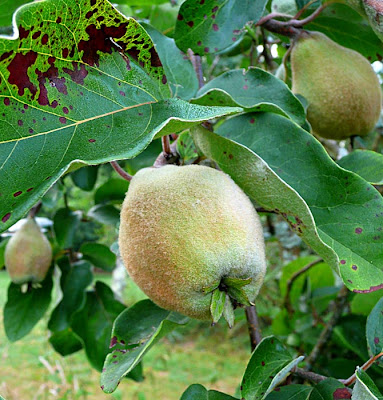I've been watching a bunch of blackthorn bushes — small trees, really — ever since spring. Now they are full of fruit. They produce little dark-purple berries called sloes in English and prunelles (little plums) in French. I've read about sloes on line and I've seen pictures that seem to confirm that these really are sloes.
I want to pick some but they are still as hard as a rock. There's a site devoted to them called sloebiz.com — it's mostly about making sloe gin, which doesn't tempt me. There and on other web pages I've read things like this about sloes:
In August, the fruits are well formed but partially hidden by the dense leaves all around. Note the characteristic 'bloom' on the sloes. Avoid the temptation to pick in August as these notoriously bitter little berries need as much time as possible to fully ripen (hence the folklore about picking 'after the first frosts').I've found several references to making jelly out of sloes, but I need to wait until October or even November to pick some. That's all I need... more jelly.
Meanwhile, there is crop after crop of bigger plums. I just looked to see why it is we call them "plums" rather than "prunes" as in French. Well, plum comes from old English plumus, which in turn derives from the Latin prunus. So it's the same word. It's just another example of linguistic corruption and confusion.
Our neighbors have four plum trees right next to each other on their property. One has green plums, one red, one purple, and one yellow. And then in a vacant lot just down the road there is a tree that is now covered with more little yellow plums than you could imagine. The branches are so weighed down that they are touching the ground. They aren't quite ripe yet.
Meanwhile, our neighbors — we're watching their yard while they are away for a week — also have a huge fig tree that has hundreds of ripe figs on it.
And our other neighbors have a quince tree that blew over in a wind storm a couple of years ago. It hasn't died; it's just lying on its side. This morning I noticed that it is not only covered in healthy-looking green leaves, but also in quinces. They're like pears but have a kind of peach fuzz on them. They make great jelly. But then so will all these millions of apples we have in the back yard...






Not that it helps, but one of the German words for plum is Pflaume (which would be the route into English), so a small one is ein Pfläumlein. In Alsace, there are people called Pflimlin - which is a how a former French prime minister came to be known as a little plum.
ReplyDeleteI know what you mean about wasting food@ and there's only so much room in a freezer, only so much jam one can eat or give away.
I think it's about time for you and Walt to set up a stand at the marché in St. Aignan or Montrichard :))
ReplyDeleteJudy
I guess the wild boar will be happy with the fruit harvest this year. Maybe the possum, hedgehogs and other nocturnal creatures also.
ReplyDeleteI'm like you- I hate to waste food. My parents taught me that since they lived in the Depression.
Ken, I'm back this evening, while you are surely snoring away happily in your bed (it's 2:00 a.m. there!), to give you a link to a recipe I just ran across for Tourte aux blettes, from the blog Le hamburger et le croissant. Here it is! I just thought you might like it, since you mention swiss chard frequently :)
ReplyDeleteJudy
Plums, shmums, I'd kill for that fig tree though.
ReplyDeleteAnd quince jam is really good with cheese.
Bonjour Judith, alors, qui t'a dit que je ronfle ? Merci pour la recette.
ReplyDeleteShelli, I'll take any extra plums you come across.